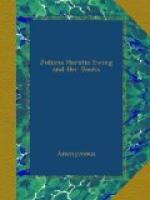[Footnote 27: “Miscellanea,” vol. xvii.]
The Preface to this book is well worth the study of those who are interested in the composition of Fairy literature; and the theories on which Julie wrote her own tales.[28]
[Footnote 28: Letter, Septuagesima, 1869.]
She also wrote (in 1875) an article on “Little Woods,” and a domestic story called “A very Ill-tempered Family.”
The incident of Isobel’s reciting the Te Deum is a touching one, because the habit of repeating it by heart, especially in bed at night, was one which Julie herself had practised from the days of childhood, when, I believe, it was used to drive away the terrors of darkness. The last day on which she expressed any expectation of recovering from her final illness was one on which she said, “I think I must be getting better, for I’ve repeated the Te Deum all through, and since I’ve been ill I’ve only been able to say a few sentences at once.” This was certainly the last time that she recited the great Hymn of Praise before she joined the throng of those who sing it day and night before the throne of God. The German print of the Crucifixion, on which Isobel saw the light of the setting sun fall, is one which has hung over my sister’s drawing-room fire-place in every home of wood or stone which she has had for many years past.
The Child Verse, “A Hero to his Hobby-horse,” came out in the Magazine volume for 1875, and, like many of the other verses, it was written to fit a picture.
One of the happiest inspirations from pictures, however, appeared in the following volume (1876), the story of “Toots and Boots,” but though the picture of the ideal Toots was cast like a shadow before him, the actual Toots, name and all complete, had a real existence, and his word-portrait was taken from life. He belonged to the mess of the Royal Engineers in the South Camp, Aldershot, and was as dignified as if he held the office of President. I shall never forget one occasion on which he was invited to luncheon at Mrs. Ewing’s hut, that I might have the pleasure of making his acquaintance; he had to be unwillingly carried across the Lines in the arms of an obliging subaltern, but directly he arrived, without waiting even for the first course, he struggled out of the officer’s embrace and galloped back to his own mess-table, tail erect and thick with rage at the indignity he had undergone.
“Father Hedgehog and his Friends,” in this same volume (1876), was also written to some excellent German woodcuts; and it, too, is a wonderfully brilliant sketch of animal life; perhaps the human beings in the tale are scarcely done justice to. We feel as if Sybil and Basil, and the Gipsy Mother and Christian, had scarcely room to breathe in the few pages that they are crowded into; there is certainly too much “subject” here for the size of the canvas!—but Father Hedgehog takes up little space, and every syllable about him is as keenly pointed as the spines on his back. The method by which he silenced awkward questions from any of his family is truly delightful:




